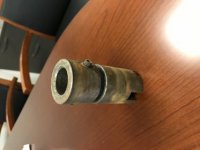R-Infrastructure
Plastic
- Joined
- Apr 11, 2017
Hello,
My company is a general contractor that has had concrete screed pulley fail on us because of what we determined is an inadequate design. Currently the shaft of the motor that turns the pulley is held onto the coupling by set screws. The shaft has a keyway already milled into it - 1/4" by 1" keyway, I will need to verify the depth but I believe it has a slight radius to the slot.
I am looking to get a matching keyway milled into our couplings (2 total) so that I can insert a key so that the set screws will not continue to shear off under the load of the screed knocking down the concrete.
I have attached some pictures. I want the keyway cut to be half the thickness of the coupling, on the same side as one of the set screws.
I will need both the couplings back and ready to install by April 24th. If nobody is able to turn around the project in this timeframe, I can arrange to do it after our next concrete pour on April 26th and just use it again with new set screws.
Hopefully this is enough information to receive a quote. I apologize for not having a design as this is just a modification of an existing product. Thanks.
edit: Just wanted to say we are based out of Chicago, Illinois, local is preferred just due to the fact that shipping times can be avoided, but not a requirement.
My company is a general contractor that has had concrete screed pulley fail on us because of what we determined is an inadequate design. Currently the shaft of the motor that turns the pulley is held onto the coupling by set screws. The shaft has a keyway already milled into it - 1/4" by 1" keyway, I will need to verify the depth but I believe it has a slight radius to the slot.
I am looking to get a matching keyway milled into our couplings (2 total) so that I can insert a key so that the set screws will not continue to shear off under the load of the screed knocking down the concrete.
I have attached some pictures. I want the keyway cut to be half the thickness of the coupling, on the same side as one of the set screws.
I will need both the couplings back and ready to install by April 24th. If nobody is able to turn around the project in this timeframe, I can arrange to do it after our next concrete pour on April 26th and just use it again with new set screws.
Hopefully this is enough information to receive a quote. I apologize for not having a design as this is just a modification of an existing product. Thanks.
edit: Just wanted to say we are based out of Chicago, Illinois, local is preferred just due to the fact that shipping times can be avoided, but not a requirement.






